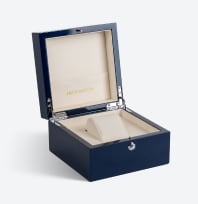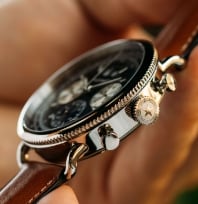Luxury watches are becoming increasingly popular each year. It’s expected that the industry will be worth more than $9 billion by 2025. In addition, mechanical watches are just as popular as ever, especially automatic watches.
Automatic watches, also sometimes called self-winding watches, are classic. They have been around for hundreds of years, and they are still the pinnacle of luxury to this day.
In this article, we’re going to explain how automatic watches work, explain the history of automatic watches, and talk about things you should look for the next time you purchase a watch.
Types of Watch Movements
There are basically two different types of watch movement—mechanical and quartz. Typically, mechanical watches are the more sought-after of the two, but there is a reason for this.
A quartz watch uses a small battery and quartz crystal to keep time. As it does so, you will notice the second hand moving around the face in “ticks” or steps. It will move over to the next second, wait, and then jump to the next.
In a mechanical watch, though, the hands move in a smooth, fluid motion around the face. This is because the hands are being moved by a piece of metal slowly unwinding itself instead of being run by an electrical power reserve.
What Are Automatic Watches?
When it comes to mechanical watches, there are two types. The first is automatic, and the other type is manual. They both function effectively the same way, but they differ in the way that the springs are wound.
In a manual watch, you have to wind it up in order to power it. With automatic watches, the watch powers the mainspring by using the kinetic energy generated by your wrist as it swings.
This means you don’t even have to wind the watch or change a battery, as long as you wear it consistently.
History of Automatic Watches
Automatic watches have been around for hundreds of years, but there is a debate regarding exactly who created the first one. In the 1770s, a Swiss inventor named Abraham-Louis Perrelet designed the first automatic mechanism for a wristwatch.
However, in 1778, another inventor by the name of Hubert Sarton publicized the technology. Sarton made sure to give credit to Perrelet, though. Unfortunately, these early designs were not without their problems.
They were not reliable and seemed to break or stop working within a few days of use. Further developments in automatic watchmaking didn’t really come about until after World War I. At that time, English watch repairer John Harwood started manufacturing automatic watches that could hold their charge for a full 12 hours.
He started selling them to the public, and other companies quickly started to follow suit. Now, it’s hard to find luxury watches that don’t have an automatic mechanical system.
How Do Automatic Watches Work?
Although this differs slightly depending on the watch, the basic concept is the same across all automatic watches.
In all mechanical watches, there are a number of components that make the watch function. The first and most important of these is the mainspring.
Mainspring
The mainspring is a spiraled piece of metal that builds tension as it is wound up. In manual watches, this is wound by twisting a small piece on the side of the watch called the crown.
In an automatic watch, there are weights that move around as the wearer moves their wrist. The energy created by this motion causes the mainspring to tighten, storing energy for the watch to use later.
Rotor
In most watches, the weight that charges the watch is a rotor. This rotor will pivot back and forth as the wearer moves their wrist. It is attached via a series of gears to the mainspring. As it moves around, it winds those gears to put tension on the mainspring.
Gear Train
The next important piece of an automatic watch is the gear train. As the mainspring slowly unwinds, the released energy is sent to the gear train. This set of gears will allow the mainspring to send energy to another piece called the escapement.
Escapement
As energy is transferred to the escapement, it acts as a braking mechanism, making sure the right amount of energy gets to the right parts of the watch. Without this, the watch would release energy far too quickly and be unable to properly keep time.
Balance Wheel
The escapement then releases that built-up energy into another section of the watch called the balance wheel. This component beats between 5-10 times per second and is what makes sure the watch stays on-time.
Watchmakers determine how fast the balance wheel beats, which in turn determines the speed of the watch.
Dial Train
The last piece that makes the watch keep time, the dial train is what actually moves the hands of the watch face. Once the energy has been tamed by the balance wheel, the gears that make up the dial train take it and move the hands of the watch.
Jewels
In most luxury watches, you’ll also find some kind of jewels. These are typically a type of synthetic ruby and help prevent friction and wear on parts of the watch. They also help increase the accuracy of automatic watches.
Preventing Overwinding
As the tension builds up in the mainspring, there is a potential for the watch to overwind itself. If that tension is not released, the watch can overwind, potentially causing the mainspring to break. In most automatic watches, there is some sort of slipping spring or other mechanisms to prevent the watch from overwinding itself.
Basically, this works by letting the mainspring “slip” if it gets too much tension in it. It will slide around the inside of the watch when the mainspring is fully wound, releasing a portion of the built-up tension and keeping it from breaking. Most automatic watches can keep going for up to two days if fully charged.
What to Look for in Automatic Watches?
With the number of automatic watches on the market, it can be hard to know what to look for when purchasing one. Truthfully, the most important thing is the simplest. You need to feel good about the watch.
A luxury watch is something you can buy now and have for the rest of your life. Potentially, it will be something you can pass onto your children and their children. You want to find something special that fits you and that you would be proud to share with future generations.
If you’re going to purchase an automatic watch, you want to buy something classic and timeless. Something like our Canton Day-Date Automatic at Jack Mason is perfect for a first automatic watch. This dress watch is modeled after some of the most timeless and classic Swiss watches ever made. Or you could consider a stainless steel bracelet watch that is chic and stylish.
In addition, you want something that is accurate and you can count on. An automatic watch should keep time on its own consistently and without you having to do anything. You should be able to set it, wear it, and not worry about it.
Should I Buy a Watch Winder?
This is a question we get asked a lot. In case you aren’t familiar with it, a watch winder is a type of rotating display case for automatic watches. It allows you to put your watch away and keep it charged even when you aren’t wearing it.
If you are someone who collects a lot of luxury watches, it can be worth having a few watch winders. That way, your watches will always be charged and on-time whenever you want to wear them.
However, if this is your first automatic watch, you may not need one. If you’re planning to wear the same watch every day, that will keep it charged on its own without you needing to keep it on a winder.
Shop Automatic Watches at Jack Mason
If you’re looking to purchase your first Swiss automatic watch, check out our collection of classic watches. We pride ourselves on offering quality watches that will last a lifetime because we believe that the watch a man wears showcases both who he is, as well as who he will become.
We have a few different styles of luxury automatic movement watches all available at an affordable price point. No matter what your style is, we have a watch that will represent you and your individual style.
In addition, all Jack Mason watches come with a lifetime warranty against any kind of manufacturing defects for the lifetime of your watch.
We have six uniquely designed collections, Aviation, Nautical, Field, Racing, Pro Diver, and Heritage, as well as a number of limited-edition series, which we number 1-100. Each men's watch we offer is built with high-quality materials including Italian leather straps, sapphire crystal, rose gold, stainless steel, and chronograph watches with Japanese and Swiss made movements. For your first luxury timepiece, there’s not a better choice than a Jack Mason.
If you are interested in learning more about luxury watches, including automatic stainless steel watches, dive watches, and strap watches, check out our journal. We would love to share our passion with you.
Sources-
http://www.historyofwatch.com/watch-history/history-of-automatic-watch/
https://www.statista.com/statistics/940452/luxury-watch-market-value-worldwide/











